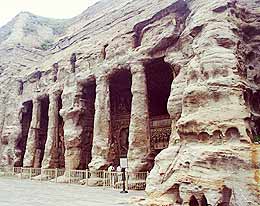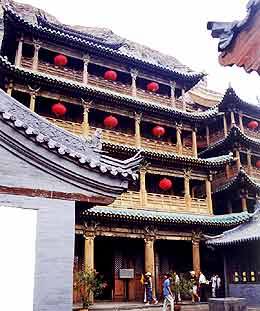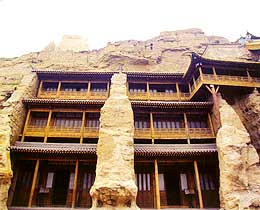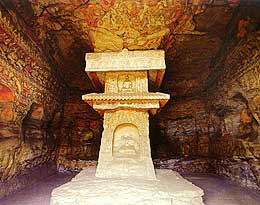Yungang Grottoes in Datong, Shanxi Province
Located at the southern foot of Wuzhou Mountain some 16 km west of Datong City, Shanxi Province, Yungang Grottoes were built against the mountain and extend about 1 km (0.62 miles) from east to west. The construction of the caves was started under the auspices of the noted monk Tan Yao in 453 and took 50 years to complete. Some 40,000 people, including the Buddhists from what is present Sri Lanka, contributed to the huge project.
The 53 grottoes in Yungang Grottos include some 1,000 niches with about 51,000 statues – a treasure-trove of cave art that combines traditional Chinese art forms with foreign influence, particularly Greek and Indian. Sculptures here are noted for their vigorous features and rich variety that range from the smallest, only 2 centimeters high, to the tallest – a Buddha 17-meters high. The tallest Buddha is surrounded by many small Buddhas in Grotto No. 5, also called the Big Buddha's Cave.
 |
Most of the grottoes are in the western zone, and each has its own character. Grotto No. 20 – one of the five earliest caves of monk Tan Yao – houses the sitting statute of Sakyamuni, 13.7 meters high, with a full and round face with a majestic smile, slim lips and a high nose, ears that extend almost to the shoulders, radiant eyes and broad shoulders. Sakyamuni statue is representative of Buddha sculptures in Yungang Grottoes.
 |
In recent past ten or so years, the Datong municipal government has intensified its efforts to protect the Yungang Grottoes. Huge investment has been made to get rid of illegal construction and to intensify landscaping efforts at the site. In December 2001, the 25th meeting of UNESCO World Heritage Committee in Helsinki, Finland, passed a decision to list Yungang Grottoes on the World Cultural Heritage List.
 |
 |
Datong Yungang Grottoes Management Office
Tel: 86-352-3026230
(China.org.cn September 12, 2003)
 0
0 







Go to Forum >>0 Comments